
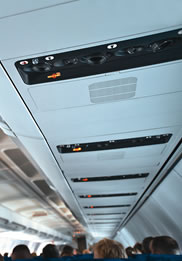
The cabins on all Boeing airplanes incorporate comprehensive fire-protective features and materials to minimize the potential for a fire and help ensure the safety of passengers.
By Arthur L. Tutson,
Boeing Organization Designation Authorization, Authorized Representative, Fire Protection;
Douglas E. Ferguson,
Technical Safety Chief, Fire Protection, Technical Services and Modifications; and
Mike Madden, Deputy Pressurized Compartment Fire Marshal, Payloads Design
A comprehensive systems-level approach in cabin design minimizes fire potential and helps ensure passenger safety.
This article is the third in a series exploring the implementation of fire protection on transport category airplanes.
Two types of fires can affect an airplane and its occupants: in-flight and post-crash. An in-flight fire usually occurs as a result of a system or component failure or maintenance issue. A post-crash fire usually results from ignition of fuel released during a crash landing. Boeing considers both types of fires when designing for airplane cabin fire protection. Fire protection is one of the highest considerations at Boeing in airplane design, testing, and certification.
In designing an airplane’s fire protection features, Boeing uses a systems-level approach that goes beyond ensuring individual parts meet fire property requirements by looking at the integration of all those parts on the airplane. This approach uses the principles of material selection, separation, isolation, detection, and control. These principles involve separating the three contributory factors to a fire (fuel, ignition source, and oxygen), isolating potential fires from spreading to other parts of the airplane, and controlling a fire should one occur. Boeing uses both passive systems (such as the use of noncombustible or self-extinguishing materials) and active systems (such as fire extinguishing systems). Fire protection features on Boeing airplanes meet all aviation regulatory requirements as well as internal Boeing design requirements.
This article describes how Boeing incorporates fire protection features and materials into the airplane cabin that meet or exceed fire protection standards defined by U.S. Federal Aviation Regulations (FAR).
Fire-protective materials
Most materials used in the construction of passenger compartment interiors are required by the U.S. Federal Aviation Administration (FAA) to be self-extinguishing (i.e., stop burning after the flame source has been removed) or better. For example, electrical wire and cable insulation must be self-extinguishing.
Interior components of Boeing airplanes meet flammability requirements prescribed in Title 14 Code of Federal Regulations (CFR) Part 25. These components include:
- Interior ceiling.
- Interior sidewall panels.
- Partitions.
- Galley surfaces and structure.
- Exposed surfaces of stowed galley carts and standard galley containers.
- Large cabinets and cabin stowage compartments.
- Passenger seat material.
For materials in areas not covered by the CFR requirements, Boeing design guidelines are used to identify additional flammability, smoke, and toxicity requirements.
The standards for flammability of insulation blankets have improved over time. A recent requirement change calls for the enhancement of the fire-protective features of insulation blankets in the event of an in-flight or post-crash fire. The latest standard increases protection by minimizing the contribution of the insulation blankets to the propagation of a fire. Thermal/acoustic insulation installed behind cabin interior panels with the appropriate fire-resistant properties can delay the onset of fire into the cabin in the event of a crash (see fig. 1). The insulation blankets, along with the airplane skin, must be capable of resisting burn-through from a fuel-fed post-crash fire next to the bottom half of the fuselage for a minimum of four minutes to allow passengers to evacuate the airplane before burn-through can occur.
Figure 1: Insulation blanket burn-through protection
Fire-protective insulation blankets are designed to resist burn-through from a fuel fire next to the bottom half of the fuselage.
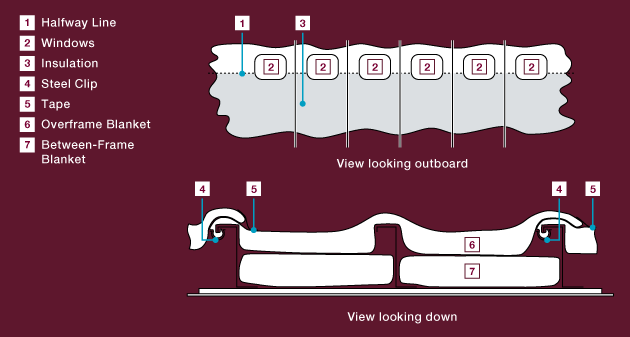
Isolation and separation controls
Boeing reviews the overall design of the airplane at a systems level to further enhance airplane safety. This includes the following based on established Boeing design guidelines:
- Identify potential ignition sources.
- Identify failure modes to ensure ignition sources are minimized.
- Establish design features to minimize potential ignitions.
- Establish design features to isolate potential ignition sources from combustibles (e.g., electrical shutoff switches for in-flight entertainment systems).
- Establish design features to contain or localize potential fires, including arrangement, materials, and ventilation. Examples include galley trash compartments, fire stops behind monuments, and sidewalls.
Fire detection
Three types of smoke detectors are certified for use in the lavatories and crew rest compartments, as well as in some galley complexes, purser work stations, video control centers, and business centers: ionization-area type, photoelectric-area type, and photoelectric-ducted type. A dedicated smoke detection system is not required in the occupied volumes of the main cabin due to the ability of passengers and the cabin crew to recognize smoke.
Ionization-area type. These detectors are designed to detect the presence of ionized particles created by the combustion process as they are convectively carried through the lavatories or crew rest compartments in the event of a fire. They are typically mounted in the ceiling or upper sidewalls of the protected space (see fig. 2).
Figure 2: Ceiling-mounted smoke detectors
Typical faceplate of a ceiling-mounted ionization smoke detector (left) and a photoelectric smoke detector (right).
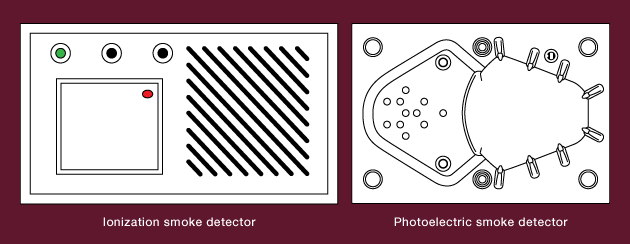
Photoelectric-area type. These detectors are designed to detect the presence of smoke particles in the air by reflection of scattered light. They also rely on particles in the air being convectively carried into a sensing chamber where light from a pilot lamp is transmitted through a sensing chamber. If smoke is present, it will reflect light onto a photocell and trigger an alarm. Newer production airplanes use photoelectric detectors based on an advanced smoke sensor utilizing two discrete wavelengths to determine the presence of smoke and to distinguish between smoke and nonsmoke aerosols. These are also mounted in the ceiling or upper sidewalls of the protected space.
Photoelectric-ducted type. These detectors are similar to photoelectric-area type detectors, but they are typically mounted behind the walls of the protected space. They differ from the area detectors in that fans draw air samples from the protected space into a series of air sampling ports in the monument walls and ceiling, and then through an aluminum tube manifold to the detectors. Current production airplanes use the more advanced area detectors mentioned above, rather than ducted photoelectric detectors.
Each smoke detection system has a built-in electronic test capability switch. This allows for the system’s electrical and detector sensor integrity to be checked at any time.
Detection of smoke is affected by compartment volume and contour, air distribution, and the amount and buoyancy of the combustion particles. Boeing conducts extensive laboratory and flight testing to determine the best location for the detector sensors to enable them to most effectively detect smoke under all conditions.
Control of fires
Handheld fire extinguishers are provided throughout the airplane cabin for manual firefighting. Boeing airplanes currently use water or Halon 1211 fire extinguishers. Boeing is working on a replacement for halon extinguishers, but it is not yet available. (For an in-depth discussion on halon, see Replacing Halon in Fire Protection Systems: A Progress Report in this issue of AERO.)
Halon 1211 fire extinguishers have a minimum Underwriters Laboratories rating of 5B:C. This type of extinguisher contains approximately 2.5 pounds (1 kilogram) of Halon 1211, weighs about 4 pounds (1.8 kilograms), and can be used on any fire likely to occur in the airplane, including paper, fabric, electrical, or flammable fluids. Halon 1211 extinguishers have also been successful in extinguishing fires behind the sidewall panels.
Water fire extinguishers have FAA technical standard order (TSO)-C19c certification approval. These units are intended to combat fires involving combustible materials such as paper and textiles.
Halon 1211 or equivalent fire extinguishers are spaced throughout the cabin and easily accessible from the aisle or entryway. A water fire extinguisher is typically located near a lavatory-galley complex. In some cases, one or more Halon 1211 extinguishers are used in place of the water fire extinguisher.
Fire extinguisher locations
Both halon and water fire extinguishers are located throughout the passenger cabin (i.e., each passenger compartment separated by doors or stairways) (see fig. 3). The minimum number of extinguishers is based on the airplane’s passenger capacity (see fig. 4).
Figure 3: Typical fire extinguisher locations
Fire extinguishers are located throughout the passenger cabin with locations designed for easy access in an emergency.
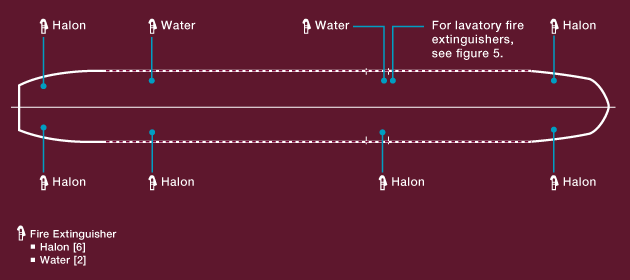
Figure 4: Distribution of handheld fire extinguishers
The number of handheld fire extinguishers on passenger airplanes is determined by the airplane’s passenger capacity.
| Airplane Passenger Capacity | Number of Extinguishers |
| 61–200 | 3 |
| 201–300 | 4 |
| 301–400 | 5 |
| Airplane Passenger Capacity | Number of Extinguishers |
| 401–500 | 6 |
| 501–600 | 7 |
| 601–700 | 8 |
Galley complex. A Halon 1211 or equivalent fire extinguisher is generally located within 8 feet (2.4 meters) of each galley complex.
Flight deck. A Halon 1211 or equivalent extinguisher is placed for easy access by the flight crew.
Crew/attendant rest compartments, purser work stations, video control centers, and business centers. At least one Halon 1211 or equivalent fire extinguisher is generally located within 8 feet (2.4 meters) of the compartment.
Lavatories. Each lavatory is equipped with fire protection systems designed to detect and extinguish fires and to prevent hazardous quantities of smoke from entering occupied areas (see fig. 5). Lavatory fire-protection features include:
- A smoke detection system that provides a warning light on the flight deck, or provides a warning light or audible warning in the passenger cabin that would be readily detected by a flight attendant.
- Each receptacle used for the disposal of flammable waste material is fully enclosed, constructed of fire-resistant materials, and able to contain fires that might occur.
- Boeing requires that all current production lavatories be capable of containing a fire for 30 minutes.
- A built-in fire extinguisher for each paper waste disposal receptacle located within the lavatory. The extinguisher is designed to discharge automatically into each disposal receptacle upon occurrence of a fire in that receptacle. All Boeing lavatories incorporated the use of Halon 1301 as the suppression agent in fire extinguishers. On Boeing production airplanes, beginning with the 777 in April 2006, these extinguishers were replaced with FM-200 (HFC-227ea). All built-in fire extinguishers meet these FAA requirements:
- No extinguishing agent that is likely to enter personnel compartments can be hazardous to the occupants.
- No discharge of the extinguisher can cause structural damage.
- The capacity of each extinguishing system must be adequate for any fire likely to occur in the compartment where used, considering the volume of the compartment and the ventilation rate.
Figure 5: Lavatory fire protection
Lavatories include systems to both detect and extinguish fires.
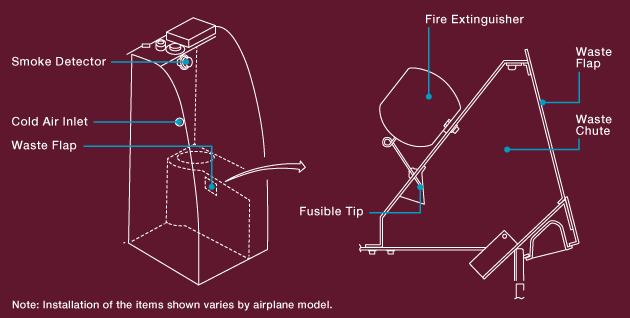
Crew rest compartment. A smoke detection system that consists of ceiling- and/or sidewall-mounted smoke detectors and associated control hardware and alarms is incorporated into crew rest compartments. Crew rest compartments are also designed to prevent hazardous quantities of smoke from entering flight crew or passenger areas.
When smoke is detected by the smoke detection system, appropriate audio and visual alarms provide indication on the flight deck, in the crew rest compartment, and in the nearby cabin areas. For larger crew rest compartments, the air distribution system’s air shutoff valve closes, preventing air-conditioning flow to the crew rest compartment to better contain smoke and facilitate crew firefighting procedures. In many instances, a minimal exhaust flow is maintained to assist in preventing smoke penetration into occupied areas and maintain visibility.
Firefighting procedures for crew rest compartments usually involve one or more members of the cabin crew using appropriate protective equipment to manually suppress the fire with a handheld fire extinguisher. In some cases, such as the 777 lower lobe attendant rest compartment, the fire is suppressed remotely by using a built-in halon fire-extinguishing system plumbed to the compartment.
Summary
Boeing uses a comprehensive systems-level approach in airplane cabin design to minimize the potential for a fire and to help ensure the safety of passengers.
For more information, please contact Art Tutson.

